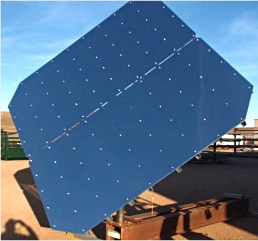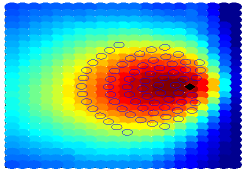Products and Services
Products
A heliostat is a reflective device that concentrates the energy from the sun onto a receiver, where it can be converted into a more useable form such as heat or electricity. This requires a special tracking mechanism that allows the heliostat to follow the sun as it moves through the sky. Heliosystems has developed a number of heliostat prototypes for different applications.
Our key product is the Passive Adjustment Toroidal Heliostat (PATH). The PATH is different from other heliostats, because it has a special 'toroidal' curvature, allowing it to achieve higher concentration of the sun's energy. It consistently outperforms other heliostats in terms of efficiency and cost effectiveness. It is the core of our commercial 'Toroidal Heliostat Solution', delivering high efficiency field layouts and a high degree of flexibility to meet the individual needs of our clients.
Current Heliostat Designs
Heliosystems' work on the improvement of the heliostat concept has lead us to create a number of different types of heliostat, providing a roadmap to our current PATH. Our products are briefly outlined below.
Passive Adjustment Toroidal Heliostat [learn more]
- Several prototype versions currently deployed
- Dual sheet 3m x 3m glass mirror surface
- Passive Focal Length Adjustment for high efficiency and adaptability
- Australian Patent Application
Conventional Toroidal Heliostat

- Developed prototype
- Dual sheet 3m x 3m ReflecTech mirror option with clipped corners for improved area to clearance radius coverage.
- Folded/punched aluminium support structure on steel chassis
- Actuator/slew and slew/slew drive options
Spherical Heliostat
- Several prototype versions currently deployed
- Dual sheet 2.4m x 3m ReflecTech mirror surface
- Folded/punched aluminium support structure on steel chassis
- Dual actuator drive.
Services
Heliosystems has created a set of versatile simulation tools for optimisation of heliostats and solar fields. These simulation capabilities allow the full characterisation of solar fields from the receiver aperture to the individual heliostats, with detailed energy analysis and optimisation routines.

Modelling can provide the road map towards the successful deployment of a CST facility by supporting each stage of the process. Modelling identifies a range of design options, offers the possibility of assessing each in a cost effective way, and provides confidence in the final design.
Current Simulation Capabilities
Heliosystems currently has available a number of simulation tools that it uses for heliostat and field optimisation. Heliosystems uses fully integrated ray tracing, flux mapping and analytical packages for speed and accuracy.
- Calculation of heliostat image profiles and flux density mapping:
- For any time of day and location.
- Full calculations of astigmatism, aberration and angular divergence.
- Flat Panel, One axis, Spherical, Toroidal and PATH
- Environmental corrections including full DNI modelling, reflectivity, tracking accuracy and manufacturing tolerances
- Collection of energy from a heliostat into an aperture:
- Energy collected into an arbitrary aperture shield shape, incl. calculations of aperture location, shape, diameter, depth and tilt angle
- Automated flux analysis for secondary receiver systems and other complex apertures
- Optimisation of heliostat focal lengths:
- Iterative optimisation of focal lengths to obtain highest power collection for heliostat and receiver parameters
- One axis, Spherical, Toroidal and PATH optimised
- Field Generation and Evaluation Techniques:
- Evaluation of energy production and efficiency of existing heliostat fields
- Optimised field layouts and aperture configurations
- Grid pattern heliostats simulated and optimised for to determine energy availability
- Non-collision fields generated along optimised focal length contours
- Full shading and blocking calculation, including optimization of blocking tolerance

© Heliosystems 2022. Home. About this site.

